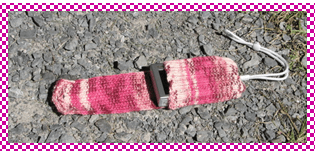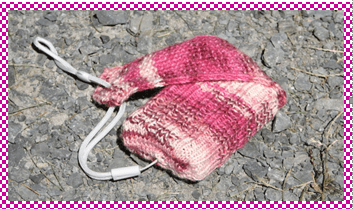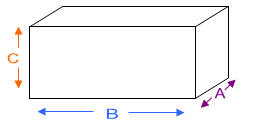Update: see end of post for information about a downloadable pattern pdf
Hey guys! Even with my hands usually full of baby lol I managed to finish and write up a pattern!
After my son Jakob was born I told my husband we had no choice but to buy a new camera. Our existing camera was huge- larger than an 80’s cell phone! It was the kind of camera I couldn’t even bring to social events like a wedding or shower as it would have required its own carrying bag and I would have looked like overdressed paparazzi. Now that we had a child, I insisted, we needed a camera small enough to keep in the diaper bag or in my pocket. There was no way I would miss those special first moments!
Buying the camera didn’t solve all of my problems, however. The camera didn’t come with a case- only a thin tufted slip of paper that it fell out of easily. Friends and family of mine have knitted themselves camera cozies, but all had the same basic design; a tube with one closed end and one ribbed end. While you could knit it as tightly as you’d like, there was nothing to officially stop the camera from falling out.
I was determined to remedy that. Buttons and Velcro were out. I knew the camera would end up in my pocket and with my luck the flap wouldn’t be properly closed and the rough Velcro side would scratch the screen, or the button would cause worse damage. There had to be a better way…
And there is!

Presenting Elphie– a camera case that will fit any flat camera. Don’t worry about knitting to a particular gauge- this worksheet will accommodate any yarn and any size needles. The case has built-in, double-layer protection over your camera’s exposed screen area and a cover that stays on and CAN’T come off, all without any snaps, ties or Velcro. Oh, and did I mention that it’s seamless? Mine were designed to fit my Canon Digital Elph camera- hence the name.

Want to make one for yourself? Here’s how!
The first thing you’ll need to do is measure your camera, so get a measuring tape and paper and pencil/pen. And the camera of course! On the paper write “A”, “B”, “C”, “S” and “R” with a dash after each. We’ll be filling in those values as we go.
Step 1
Measure your camera and fill in the values for A, B and C on your paper, in inches.

Knit a 4″ x 4″ gauge swatch with your desired yarn and needles. Measure the swatch and figure out the number of stitches (S) and number of rows (R) for 1 (one) inch. Fill in the values on your paper.
Step 2
Multiply your stitch gauge by the width (C) of your case.
S_____ x C_____ = CO_____ sts. (If this results in an even number, add 1 to get an odd number of sts.
Begin knitting:
The case starts at the flap, knitted flat in Moss Stitch, then stitches are cast on for the body of the case which is knit in the round in ribbing.

Cast on the resulting CO value you obtained above.
Multiply your row gauge by the depth (A) of your case.
R_____ x A_____ = D_____ rows.
Work in Moss stitch for half this number of rows (D_____/2).
Next row: work in Moss Stitch until halfway across the row, BO 2 sts, then continue in Moss Stitch (paying attention to the pattern as established) to the end of the row.
Next row: Work in Moss Stitch until the gap created by the bound-off stitches, CO 2 sts, then continue in Moss Stitch (paying attention to the pattern as established) to the end of the row.
Continue working in Moss Stitch until your knitting reaches the length of A+B+A.
A_____ + B_____ + A_____ = _____inches.
Multiply your stitch gauge by the full measurement of your case.
S_____ x (C_____ + A_____ + C_____ + A_____) = M_____
Adjust this new number to the closest lower number that is a multiple of 4. AM=____
(For example, if your M = 28, the closest lower number below that which is divisible by 4 is 24, so your AM would = 24).
Subtract the number of sts you cast on from the adjusted measurement.
AM_____ – CO_____ = _____
Place a marker at the beginning of the next row, work in Moss Stitch across the row, then CO the resulting number of sts you just got after the last equation. Your total stitch count should now equal AM_____
NOTE: if you prefer a snugger case, subtract 4, 8 or 12 from the number of sts to cast on in the previous instruction.
Join in the round, being careful not to twist. Your stitch marker will serve as the beginning of each round.

Work in 2×2 rib until the tube portion of the case measures the length of B and half of A.
B_____ + (A_____/2) = _____ inches.
Make sure your stitches are evenly arranged on 4 needles, with 1/4 of the sts on each needle. (For example, if your AM = 24 sts, then you would have 6 sts on each of the 4 needles).
Decrease round: Ndl 1: ssk, k to 1 st before the end of needle, BO 1 st. Ndl 2: BO 1 st, k to 2 sts before end of needle, k2tog. Ndl 3: ssk, k to end of needle. Ndl 4: k to 2 sts before end of needle, k2tog.
Next round: Ndl 1: k to the end of the needle, CO 2 sts, Ndls 2-4: knit across
Continue in stockinette stitch until, counting from the decrease round, you have knit 2 rows less than D_____/2.
Finishing
Turn your work inside out and work a 3-Needle Bind-Off on the remaining stitches. Weave in all ends.

How To Use
To place the camera in the case, pull your camera’s strap through the hole at the bottom. Insert camera fully into case positioned so that the long flap folds over the screen area of your camera, providing it with a double layer of protection. Pull the camera strap through the hole in the flap to secure the flap shut.

And there you have it!
Feel free to knit as many of these as you like, and you can even sell items made from this pattern as long as you credit me as the designer of the pattern.
Update!
This pattern is on Ravelry here.
This pattern is provided free above, but if you’d prefer an easy-to-print PDF version, I have made it available here for a very small fee. The PDF includes the full instructions in an easy-to-follow worksheet, the definition of all abbreviations used in the pattern, yardage requirements, as well as instructions on the Moss Stitch, Ribbing and 3-Needle Bind-Off used in the pattern.
*Updated January 2020


